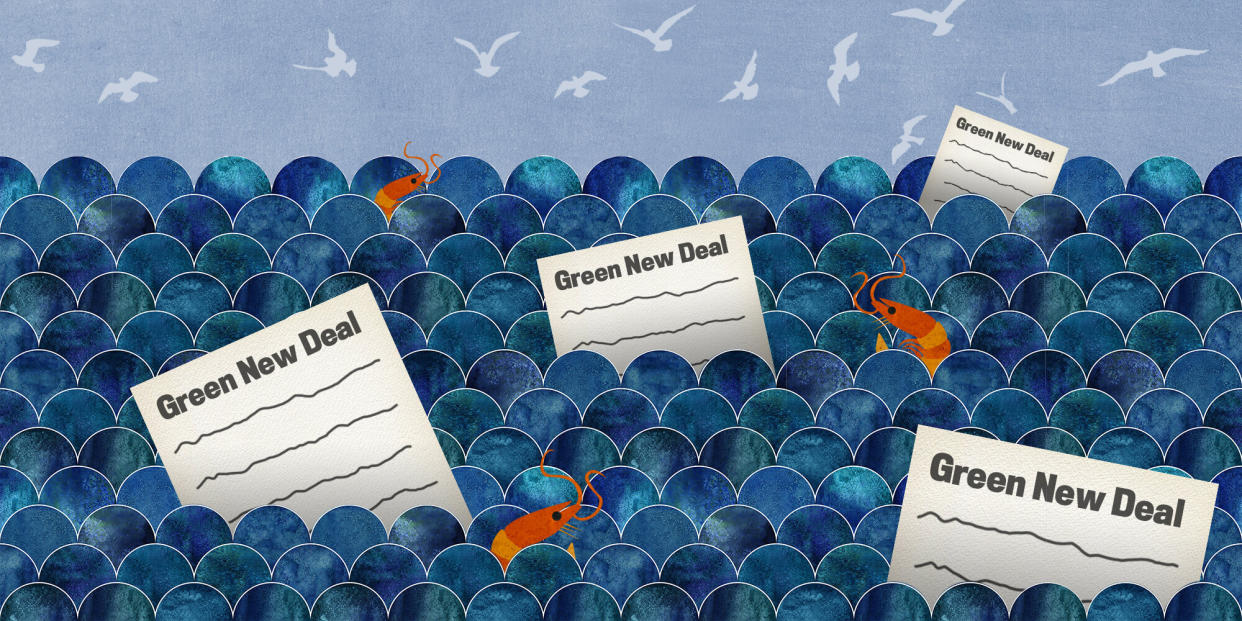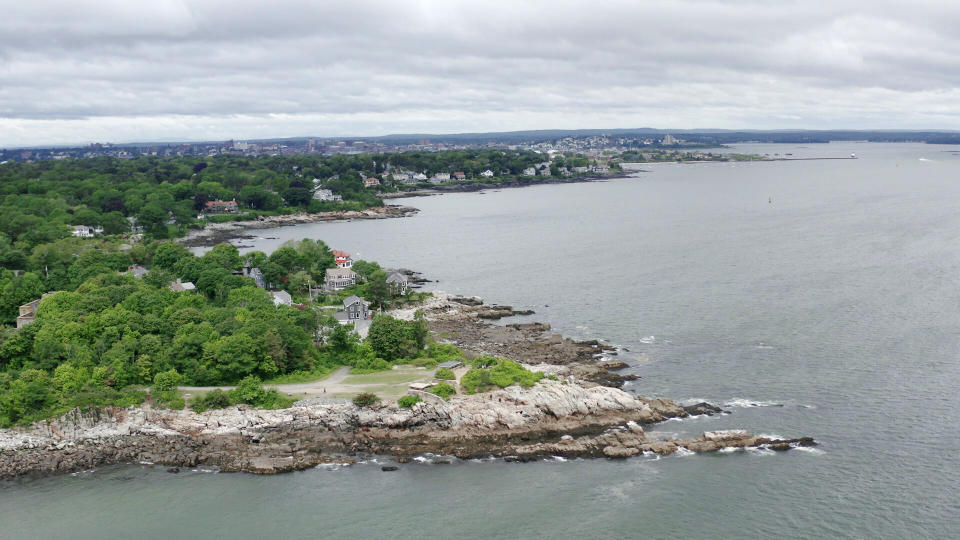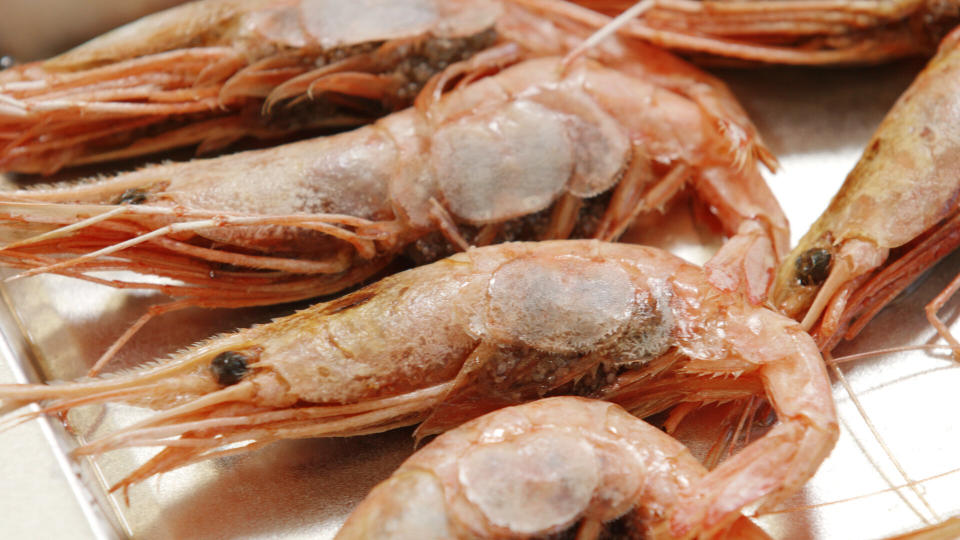There’s One Big Climate Crisis We’re Not Talking About

CUNDYS HARBOR, Maine ― When winter fell on this quiet, wooded island, instinct took over. Birds flew south. Trees shed leaves. Dain Bichrest set his alarm for 3 a.m.
Reaching a calloused hand through the frigid darkness, he silenced the device, stretched and started a routine that finished with the sea captain boarding his 42-foot boat and voyaging two hours into the Gulf of Maine to fishing grounds teeming with Northern shrimp. It became so routine he’d start to wake automatically.
For fishermen like Bichrest, the small, tangerine-pink curlicues ― whose tenderness and sweet taste chefs from Manhattan bistros to New England clam shacks prize as a delicacy ― provided a supplemental source of income in the cold months after lobster season peaked in mid-December.
For decades, a good day trawling the undersea gulches where Pandalus borealis thrive meant hauling 10,000 pounds of shrimp from the Gulf of Maine’s deeps. A bad day netted a catch closer to 1,000 pounds.
That’s the way it used to be. These days, to use a descriptor made saltier by Bichrest’s thick Downeast accent, the fishing is just shit.
In 2013, record-low levels of recruitment ― younger shrimp reaching breeding age ― compelled regional regulators to close the Gulf of Maine to shrimping. Six years later, the shrimp show no significant signs of recovery. Where previous periods of decline have been blamed on overfishing, this time the drop off is being attributed to a bigger force: climate change.
Anxiety is giving way to anger as fishers ― sentimental about tradition and skeptical of science ― find themselves pitted against regulators and environmentalists they vilify as more concerned with projections on paper than real-life livelihoods.

“To them, anyone out there trying to make a living is ruining the earth,” Bichrest, 57, said on a late August afternoon, as a crisp, briny breeze blew in from the harbor, heralding the end of summer. “We weren’t getting rich, but at least then we weren’t taking money out of the bank to survive.”
Shrimping generated on average $16 million a year, according to the Maine Coastal Fishermen’s Association. That’s nowhere close to the state’s $500 million-a-year lobster business. But when the fishery closed, Bichrest saw 25% of his yearly projected income evaporate overnight. He was one of the lucky ones. Other captains were forced to sell the small boats primarily used for shrimping and take out loans to buy the vessels and gear needed to make the switch to lobstering. The new competition for lobsters made things even harder.
This tale of precarity has become increasingly common as global temperatures rise. The plot – in which blue-collar workers are caught between the proverbial rock of the climate crisis and the hard place of a clunky policy response – tracks with a narrative typically associated with Appalachian coal miners. But while other energy sources can replace coal, demand for fish hit record highs in recent years, and programs to help fishermen adapt to changing needs remain poorly tailored to the pressures that come with climate change.
It’s the sort of problem the Green New Deal was meant to solve. The emerging policy framework calls for cutting planet-heating emissions to zero while also providing millions of workers, particularly those in industries like fossil fuels, with jobs that sustain economies and ecologies at the same time. Its proponents envision a transformation on the scale of the 1930s’ New Deal. In place of dams, highways and World War II weapons, the Green New Deal, as it’s been outlined, promises sea walls, electric cars and a revitalized Middle America, where coal miners tend to wind turbines and farmers till heat-trapping carbon dioxide into soil.
It says virtually nothing about oceans or the plight of the coastal seafood industry. That gap has led some to now call for a “Blue New Deal,” a federal program to spur new, ecologically-sound markets for fishermen. Yet the appeal of farming seaweed and shellfish, or processing seafood locally, could be limited for workers who aren’t convinced changing the old ways is necessary at all.
“We’d be luckier if we were just left alone,” Bichrest said.
An Irregular ‘Heartbeat’
It’s not hard to see why Bichrest resents changes dictated from beyond his chain of craggy islands. The road that leads south to the barnacled dock where he casts off cuts through an uninterrupted scene of wholesome New England idyll. Old men sell wild blueberries on the side of the road. Wooden signs hawk what claim to be the world’s best lobster rolls. Blue coves peak through towering, salt-sprayed pines to the east and west. Bichrest spent his entire life here. His grandfather fished these waters. So did his father. So do his five brothers.
He’ll be the first to admit the last time the shrimp fishery closed for this long, it was their fault. “Guys fished year-round and killed everything,” Bichrest said.
By the early 1970s, overfishing had decimated the populations of cod, sea urchins and Northern shrimp, prompting regulators to close fisheries. “But the shrimp came back fairly quickly,” said Bichrest.
By the time the fishery reopened in 1979, the shrimp had rebounded. The population stayed relatively healthy over the next three decades as laws passed in response to overfishing made U.S. fisheries among the best managed in the world.
Problems remained, however, including those 1970s lawmakers failed to foresee. Between 2010 and 2012, fishermen exceeded the recommended catch level by about 36%, according to the Atlantic States Marine Fisheries Commission’s 2018 report assessing the Northern shrimp. Yet, this time, something more disruptive was taking place below the surface.
Stretching from Nova Scotia to Cape Cod, the Gulf of Maine sits at the intersection of two major ocean currents. From the north comes the Labrador Current pulsing cold water from Greenland down North America’s eastern coast. From the south comes the mighty Gulf Stream carrying warm water from the Gulf of Mexico. The interaction of the currents causes what University of Washington oceanographer Hillary Scannell described to the science magazine Eos as the “heartbeat of the Atlantic Ocean.”

Historically, the Labrador Current easily flowed into the Gulf of Maine, providing the cool temperatures in which shrimp and other fish thrive. But melting Arctic ice is adding fresh water to the northern seas. This weakens the Labrador Current, and warm Gulf Stream water cooks the Gulf of Maine. The effects are stunning.
The Gulf of Maine has warmed faster than 99% of global oceans, increasing by an average of 0.11 degrees Fahrenheit per year over the last three decades. A heatwave in 2018 saw the sea surface temperature rise to 68.938 degrees Fahrenheit, just shy of the record 68.98 degrees Fahrenheit record set in August 2012. While sea temperatures fluctuate, the overall trend points firmly upward.
The relationship between water temperature and the population of Northern shrimp is complicated, but adult females require colder waters to spawn. Typically, by early fall, egg-bearing females migrate closer to shore, where the eggs hatch. There, the babies feed on plankton and invertebrates, and in turn, become vital prey for fish such as cod, redfish and hake, according to the regional fisheries commission. The number of shrimp that survive and mature to reproductive age varies year to year.
But since 2000, the fluctuations have been more extreme, with higher highs and lower lows compared to the period from 1984 to 1999. While 2015 saw above-average numbers of younger shrimp reaching breeding age, four of the last eight years were the lowest on record, according to the latest commission report. The trend points in a downward direction. In 2017, recruitment topped 2.05 billion shrimp. That may sound like a lot, but a median level of recruitment is 4.38 billion.
“We haven’t been clear on what the relationship between temperature and shrimp is,” said Hsiao-Yun Chang, an ecologist at the University of Maine. “We are assuming warm temperatures are not good for recruitments.”
That scientifically-mandated couching fuels the kind of conspiratorial thinking already gripping some fishers.
Here in Cumberland County, roughly an hour north of the liberal enclave of Portland, 70% of adults recognize that the planet is warming, and 56% understand that humans are the cause, the latest polling data from the Yale Program on Climate Change Communication show. The district voted overwhelmingly for Democrat Hillary Clinton over Republican Donald Trump in the 2016 election. But Bichrest, a Trump supporter who rolls his eyes at “this global warming shit,” counts himself and some of his fellow fishers among the 56% who believe human-caused climate change won’t inflict personal harm.
He backs himself up with anecdotes. Bichrest said his brother routinely catches Northern shrimp while trawling for hake fish with a 6.5-inch mesh net. That, he said, is a sign the crustaceans are doing well, since normally shrimp require a tighter, 1.9-inch mesh. Gut one of the silvery hake fish, and “you’ll find their stomachs are packed with shrimp,” he said.
“But hey, they don’t want to listen to guys like us,” he said. “Your opinion means nothing, you’re just the guy who’s been doing it your whole life.”
But that assessment, scientists say, is based on a misunderstanding.
“Northern shrimp come together most likely for reproductive activities,” said Chang. “The high density of the shrimp population doesn’t mean high abundance.”
Yet the schools of shrimp warp fishermen’s perception, said Andrew Pershing, the chief scientific officer at the Gulf of Maine Research Institute.
“I have no doubt fishermen are seeing shrimp in particular areas and from time to time encounter them in abundance,” he said. But the science doesn’t point to a sustained revival of shrimp.
The number of younger shrimp surviving to breeding age has remained “low to extremely poor” for the past seven years, the Atlantic States Marine Fisheries Commission’s report read. In 2018, when yet another marine heatwave sent temperatures soaring, numbers hit “an all-time low.” “The Northern shrimp stock is currently depleted,” the report added.
It’s possible that the temperatures could continue to fluctuate, and “we could have a period of five or 10 years or so where things could cool down and make things more hospitable for shrimp,” Pershing said.
“The challenge is it might cool down, but due to warming on the planet, we won’t return to the cold conditions we had in the past that allowed the shrimp population to build up,” he said. “It’d likely be mild and temporary.”
‘A One-Gun Fishery’
Fishermen in Maine have seen the diversity of their catches narrow, which makes them all the more vulnerable. Groundfish – including cod, haddock and flounder – once represented the most lucrative seafood sector in Maine, but overfishing in the 1990s took a toll. In response, Congress introduced new laws to try to rebuild the species, including establishing quotas, limiting days at sea, and restricting the type of gear fishermen used.
Fishermen who once profited off a groundfishing free-for-all now faced tighter rules and more competition, and started lobstering in the summer and fall and shrimping in the winters. Losing the shrimp, Bichrest, said, has backed many fishermen “into a corner.”
“They’ve made this a one-gun fishery,” he said. “Problem is, if lobsters go to hell, we’re done.”
Love HuffPost? Become a founding member of HuffPost Plus today.

As lobsters started migrating north in recent decades, seeking cooler waters, Maine saw a windfall. In August 2004, lobstermen in the state hauled nearly 12.2 million pounds of the crustaceans, worth just shy of $45.6 million in a single month, according to data from Maine’s Department of Marine Resources. By August 2017, those figures more than doubled, with about 28.6 million pounds selling for close to $99 million.
But even that sector faces headwinds.
In June 2018, the Chinese government slapped 25% tariffs on imports of U.S. crustaceans as its trade war with the United States escalated. The move sent shockwaves through a U.S. industry that, in 2017, exported $132 million worth of lobster to China, according to Maine Lobster Dealers Association data. Lobster dealers felt the sting, and rushed to secure new markets in other parts of Asia and Latin America. So far, lobster prices have remained relatively steady, but these new hurdles have shaken the industry.
Rising ocean temperatures also pose a serious threat. In the short term warmer waters have helped the industry boom, driving lobster northward from the Long Island Sound, making the lobster fishery in Maine more successful than ever. Just 50% of lobster caught in the United States came from Maine in the 1980s and 1990s, Reuters reported last year. That figure has soared to 85% in the past decade. But as the ocean temperatures continue to trend upwards, fishers fear that the boom will be followed by bust as the crustaceans carry on their journey northwards.
“It’s probably not going to stay this high forever,” said Ben Martens, executive director of the Maine Coast Fishermen’s Association.
A Blue New Deal
Ayana Elizabeth Johnson, a scientist and chief executive of the nonprofit Ocean Collectiv, sees opportunity in the growing concern over the lack of market diversification.
She is now one of the leading voices calling for what she dubbed a “Blue New Deal.” In a white paper for the left-leaning think tank Data for Progress, she and four co-authors proposed a suite of policies to revitalize coastal economies and establish new markets for aquatic businesses that help lower planet-heating emissions.
The memo includes a range of policies intended to favor fish caught in the United States over cheap imported catch and encourage fishermen to start farming algae, shellfish and seaweed. Marine flora, such as seaweed and mangroves, can absorb more than 20 times more carbon dioxide from the atmosphere than land-based forests, according to the nonprofit Oceana.
“Fishing, farming, coal mining ― these are the professions that have always been able to make an honest living by just going out, working hard and extracting natural resources or working with nature to create them,” Johnson said. “We’re having to just rethink all of that.”
The key, she said, isn’t just to remake the industry in Maine or another seafood hub like Alaska; an ideal scenario would mean “growing food up and down our coasts.”
“Being able to provide local seafood that’s sustainable and maybe actually sequestering carbon for our predominantly coastal population in the U.S. is a big deal,” she said.
For now, that’s a difficult future for some to envision. “While aquaculture is going to be part of our blue economy in Maine, it’s a very different set of skills to be a fishermen versus a farmer,” Martens said. “Aquaculturists are farmers. Some fishermen are good at that. Some aren’t.”
Instead, Martens said it’s critical to consider other fisheries, including monkfish and scallops, which are starting to become more abundant in the Gulf of Maine. Another pressing concern, he said, is the new push to build offshore wind turbines to lower the state’s dependence on gas for electricity.
“You put a wind farm in the wrong place,” he said, “and that could mean an entire community loses fishing grounds.”
As dozens of boats sat still in the harbor on a sunny early afternoon in August, Bichrest offered a glimpse of what that loss looks like.
“That blue boat would be shrimping, that white boat would be shrimping, that other white one, too,” he said, pointing out different vessels bobbing gently in the calm waters.
He fears that, if the lobster business faces a downturn, the effect on young fishermen who invested their savings into boats, gear and permits will be devastating.
“The guys who are just getting going like it was never going to end, they haven’t been through the cycles,” he said. “It’s like the stockmarket. It gets better and better. Then, all of a sudden, people are jumping out windows.”
If it matters to you, it matters to us. Support HuffPost’s journalism here. For more content and to be part of the “This New World” community, follow our Facebook page.
HuffPost’s “This New World” series is funded by Partners for a New Economy and the Kendeda Fund. All content is editorially independent, with no influence or input from the foundations. If you have an idea or tip for the editorial series, send an email to thisnewworld@huffpost.com
Related Coverage
Scientists Say Red Tide Is Back Along Florida's Southwest Coast
Fearing Devastation, Coral Scientists Begin Post-Dorian Reef Surveys
I Ignored The Urgency Of Addressing Climate Change. Then My House Caught On Fire.
This article originally appeared on HuffPost.

